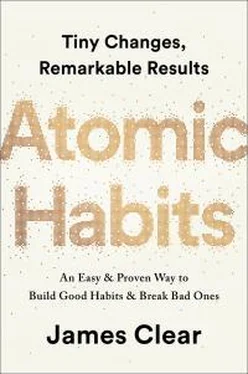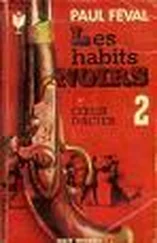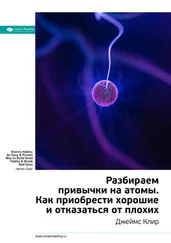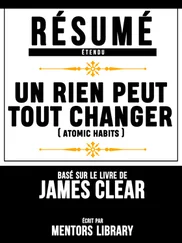Habit formation is incredibly useful because the conscious mind is the bottleneck of the brain. It can only pay attention to one problem at a time. As a result, your brain is always working to preserve your conscious attention for whatever task is most essential. Whenever possible, the conscious mind likes to pawn off tasks to the nonconscious mind to do automatically. This is precisely what happens when a habit is formed. Habits reduce cognitive load and free up mental capacity, so you can allocate your attention to other tasks.
Despite their efficiency, some people still wonder about the benefits of habits. The argument goes like this: “Will habits make my life dull? I don’t want to pigeonhole myself into a lifestyle I don’t enjoy. Doesn’t so much routine take away the vibrancy and spontaneity of life?” Hardly. Such questions set up a false dichotomy. They make you think that you have to choose between building habits and attaining freedom. In reality, the two complement each other.
Habits do not restrict freedom. They create it. In fact, the people who don’t have their habits handled are often the ones with the least amount of freedom. Without good financial habits, you will always be struggling for the next dollar. Without good health habits, you will always seem to be short on energy. Without good learning habits, you will always feel like you’re behind the curve. If you’re always being forced to make decisions about simple tasks—when should I work out, where do I go to write, when do I pay the bills—then you have less time for freedom. It’s only by making the fundamentals of life easier that you can create the mental space needed for free thinking and creativity.
Conversely, when you have your habits dialed in and the basics of life are handled and done, your mind is free to focus on new challenges and master the next set of problems. Building habits in the present allows you to do more of what you want in the future.
THE SCIENCE OF HOW HABITS WORK
The process of building a habit can be divided into four simple steps: cue, craving, response, and reward.* Breaking it down into these fundamental parts can help us understand what a habit is, how it works, and how to improve it.
FIGURE 5: All habits proceed through four stages in the same order: cue, craving, response, and reward.
This four-step pattern is the backbone of every habit, and your brain runs through these steps in the same order each time.
First, there is the cue. The cue triggers your brain to initiate a behavior. It is a bit of information that predicts a reward. Our prehistoric ancestors were paying attention to cues that signaled the location of primary rewards like food, water, and sex. Today, we spend most of our time learning cues that predict secondary rewards like money and fame, power and status, praise and approval, love and friendship, or a sense of personal satisfaction. (Of course, these pursuits also indirectly improve our odds of survival and reproduction, which is the deeper motive behind everything we do.)
Your mind is continuously analyzing your internal and external environment for hints of where rewards are located. Because the cue is the first indication that we’re close to a reward, it naturally leads to a craving.
Cravings are the second step, and they are the motivational force behind every habit. Without some level of motivation or desire—without craving a change—we have no reason to act. What you crave is not the habit itself but the change in state it delivers. You do not crave smoking a cigarette, you crave the feeling of relief it provides. You are not motivated by brushing your teeth but rather by the feeling of a clean mouth. You do not want to turn on the television, you want to be entertained. Every craving is linked to a desire to change your internal state. This is an important point that we will discuss in detail later.
Cravings differ from person to person. In theory, any piece of information could trigger a craving, but in practice, people are not motivated by the same cues. For a gambler, the sound of slot machines can be a potent trigger that sparks an intense wave of desire. For someone who rarely gambles, the jingles and chimes of the casino are just background noise. Cues are meaningless until they are interpreted. The thoughts, feelings, and emotions of the observer are what transform a cue into a craving.
The third step is the response. The response is the actual habit you perform, which can take the form of a thought or an action. Whether a response occurs depends on how motivated you are and how much friction is associated with the behavior. If a particular action requires more physical or mental effort than you are willing to expend, then you won’t do it. Your response also depends on your ability. It sounds simple, but a habit can occur only if you are capable of doing it. If you want to dunk a basketball but can’t jump high enough to reach the hoop, well, you’re out of luck.
Finally, the response delivers a reward. Rewards are the end goal of every habit. The cue is about noticing the reward. The craving is about wanting the reward. The response is about obtaining the reward. We chase rewards because they serve two purposes: (1) they satisfy us and (2) they teach us.
The first purpose of rewards is to satisfy your craving . Yes, rewards provide benefits on their own. Food and water deliver the energy you need to survive. Getting a promotion brings more money and respect. Getting in shape improves your health and your dating prospects. But the more immediate benefit is that rewards satisfy your craving to eat or to gain status or to win approval. At least for a moment, rewards deliver contentment and relief from craving.
Second, rewards teach us which actions are worth remembering in the future. Your brain is a reward detector. As you go about your life, your sensory nervous system is continuously monitoring which actions satisfy your desires and deliver pleasure. Feelings of pleasure and disappointment are part of the feedback mechanism that helps your brain distinguish useful actions from useless ones. Rewards close the feedback loop and complete the habit cycle.
If a behavior is insufficient in any of the four stages, it will not become a habit. Eliminate the cue and your habit will never start. Reduce the craving and you won’t experience enough motivation to act. Make the behavior difficult and you won’t be able to do it. And if the reward fails to satisfy your desire, then you’ll have no reason to do it again in the future. Without the first three steps, a behavior will not occur. Without all four, a behavior will not be repeated.
THE HABIT LOOP
FIGURE 6: The four stages of habit are best described as a feedback loop. They form an endless cycle that is running every moment you are alive. This “habit loop” is continually scanning the environment, predicting what will happen next, trying out different responses, and learning from the results.*
In summary, the cue triggers a craving, which motivates a response, which provides a reward, which satisfies the craving and, ultimately, becomes associated with the cue. Together, these four steps form a neurological feedback loop—cue, craving, response, reward; cue, craving, response, reward—that ultimately allows you to create automatic habits. This cycle is known as the habit loop.
This four-step process is not something that happens occasionally, but rather it is an endless feedback loop that is running and active during every moment you are alive—even now. The brain is continually scanning the environment, predicting what will happen next, trying out different responses, and learning from the results. The entire process is completed in a split second, and we use it again and again without realizing everything that has been packed into the previous moment.
Читать дальше




![Джеймс Клир - Атомные привычки [Как приобрести хорошие привычки и избавиться от плохих]](/books/403243/dzhejms-klir-atomnye-privychki-kak-priobresti-horosh-thumb.webp)



